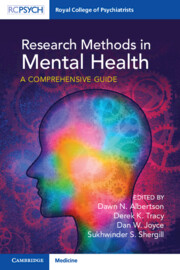Book contents
- Research Methods in Mental Health
- Reviews
- Research Methods in Mental Health
- Copyright page
- Contents
- Contributors
- Foreword
- Foreword
- Section 1 Principles of Research
- Section 2 Tools and Methodologies
- Chapter 6 Using Clinical Data
- Chapter 7 Clinical Trials
- Chapter 8 Principles of Psychological Assessment
- Chapter 9 Qualitative Research
- Chapter 10 Epidemiology and Population Level Research
- Chapter 11 Digital Innovation in Mental Health
- Section 3 Contemporary Applications
- Index
- References
Chapter 6 - Using Clinical Data
from Section 2 - Tools and Methodologies
Published online by Cambridge University Press: 31 October 2025
- Research Methods in Mental Health
- Reviews
- Research Methods in Mental Health
- Copyright page
- Contents
- Contributors
- Foreword
- Foreword
- Section 1 Principles of Research
- Section 2 Tools and Methodologies
- Chapter 6 Using Clinical Data
- Chapter 7 Clinical Trials
- Chapter 8 Principles of Psychological Assessment
- Chapter 9 Qualitative Research
- Chapter 10 Epidemiology and Population Level Research
- Chapter 11 Digital Innovation in Mental Health
- Section 3 Contemporary Applications
- Index
- References
Summary
The traditional case register involved assembling records of people with a given condition in order to support cohort studies to describe and investigate the course of their condition and other outcomes. This old design has been resurrected and revolutionised following the widespread implementation of fully electronic healthcare records over the past few decades, providing ‘big data’ resources that are both large and very detailed. These, in turn, are being further enhanced through linkages with complementary administrative data (both health and non-health) and through natural language processing generating structured meta-data from source text fields. This chapter provides an overview of this rapidly developing research infrastructure, considering and advising on some of the challenges faced by researchers planning studies using clinical data and by those considering future resource development.
Keywords
Information
- Type
- Chapter
- Information
- Research Methods in Mental HealthA Comprehensive Guide, pp. 81 - 94Publisher: Cambridge University PressPrint publication year: 2025
References
Accessibility standard: WCAG 2.0 A
Why this information is here
This section outlines the accessibility features of this content - including support for screen readers, full keyboard navigation and high-contrast display options. This may not be relevant for you.Accessibility Information
Content Navigation
Allows you to navigate directly to chapters, sections, or non‐text items through a linked table of contents, reducing the need for extensive scrolling.
Provides an interactive index, letting you go straight to where a term or subject appears in the text without manual searching.
Reading Order & Textual Equivalents
You will encounter all content (including footnotes, captions, etc.) in a clear, sequential flow, making it easier to follow with assistive tools like screen readers.
You get concise descriptions (for images, charts, or media clips), ensuring you do not miss crucial information when visual or audio elements are not accessible.
Visual Accessibility
You will still understand key ideas or prompts without relying solely on colour, which is especially helpful if you have colour vision deficiencies.
Structural and Technical Features
You gain clarity from ARIA (Accessible Rich Internet Applications) roles and attributes, as they help assistive technologies interpret how each part of the content functions.
